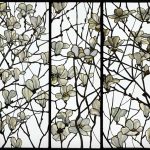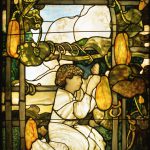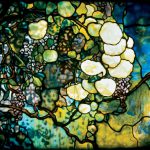The exhibition features about 100 objects from the Morse Museum’s comprehensive Tiffany collection. These range from silver-and-ivory cuff links worn by the artist to important leaded-glass windows produced by Tiffany and eventually installed at Laurelton Hall, the Long Island country estate that was the most extensive personal project of his career. The Museum’s collection of objects from Laurelton Hall was featured in a major exhibition at the Metropolitan Museum of Art in New York from November 2006 through May 2007, and the five windows from Laurelton Hall that exhibited in this show have not been on view at Morse for more than two years. Quest of Beauty will run through January 25, 2009.
Quest of Beauty is organized into five major phases of Tiffany’s life. These include his early years as a painter; the decade in which he established himself as a decorator to New York’s upper class; his evolution as a master designer of both interiors and objects in the last decade of the 19th century; and the first years of the 20th century in which Tiffany’s business expanded, and he achieved status as an international star in the decorative arts. Finally, the exhibition addresses his years in retirement amidst the changing tastes of the time.
Tiffany’s Formative Early Years
1848–1878: Birth to Age Thrity
As a young man, Louis Tiffany, the privileged son of Tiffany & Co. founder Charles Lewis Tiffany, was drawn to art. When enrolled at Eagleswood Military Academy in New Jersey, he met and informally studied with the famous painter George Inness. Pursuing his passion for color and form in earnest, he was by the age of 19, a founder and member of the American Society of Painters in Water Color and a regular exhibitor at the National Academy of Design. Highlights from this section of the exhibition include an 1864 award to Tiffany for “Proficiency in Drawing,” an 1865 sketchbook produced by Tiffany on his first trip to Europe, and four watercolor studies of Arabs that Tiffany painted from 1870 to 1873.
Tiffany’s Rise as a Leading American Decorator
1879–1887: The Artist in His Thirties
Though still active as a painter, Tiffany in his 30s made his mark as a leading New York designer/decorator. Already ensconced in an elite American art circle, Tiffany at this time also was seeking art patents for the type of glass and the glassmaking techniques he was using. In New York, commissions included the homes of chemical and drug magnate George Kemp and American statesman Hamilton Fish, the Lyceum Theatre, and the Seventh Regiment Armory. Elsewhere, he created interiors for the White House, the Ponce de León Hotel in Florida (now Flagler College), and the Connecticut residence of writer Mark Twain. During this period, Tiffany collaborated as well with Stanford White on a grand house for the Tiffany family at Madison Avenue and 72nd Street in New York. From this period, the exhibition showcases, among other things, the Eggplant leaded-glass window from the Kemp house, c. 1879; Tiffany’s sketch of the 72nd Street apartment, c. 1883; and the Magnolia leaded-glass window panels, c. 1885, that were designed for his 72nd Street residence and then eventually installed at Laurelton Hall.
Tiffany Attains Artistic and Commercial Success
1888–1900: The Artist in His Forties
In his 40s and early 50s, Tiffany went on to become a heralded leader in the decorative arts of the time, creating a legacy that continues to be widely loved and admired more than a century later. In 1890, he would with Samuel Colman undertake one of the most prestigious and widely recognized commissions of his career, the New York home of prominent art patrons Louisine and Henry Havemeyer. Not long thereafter, he created the chapel interior for the 1893 World’s Columbian Exposition that won medals and accolades as well as the international favor he had long pursued. (The chapel is on permanent exhibition at the Morse.) Siegfried Bing, the French art dealer, became Tiffany’s chief representative in Europe. From this period, the exhibition features the “Feeding the Flamingoes” leaded-glass window exhibited at the 1893 world’s fair; the Child with Gourd leaded-glass window, c. 1898, designed by Frank Brangwyn and executed by Tiffany for Bing’s 1899 “L’Art Nouveau” show at Grafton Galleries in London; as well as an example of a nautilus shell lamp, which was also exhibited in London as one of Tiffany’s earliest—and most innovative—leaded-glass lampshade designs. At the 1900 Exposition Universelle in Paris, Tiffany exhibited lamps, enamels, mosaics, art glass, and windows, one of which was the celebrated Four Seasons from the Morse collection, and was awarded the Chevalier de l’Ordre National de la Légion d’honneur by the French government. The “Spring” panel from the Four Seasons window will be on view in this section of the exhibition.
Tiffany’s Laurelton Hall Years
1901–1915: Age Fifty-three to Sixty-seven
By the turn of the 20th century, Tiffany had clearly proved himself as both a world-class artistic talent and an effective manager and promoter. Despite earlier financial dependence on his father’s capital, Tiffany’s firm was now successful on its own. Tiffany’s father, however, died in 1902 leaving his son a fortune in excess of $3 million. The same year, Tiffany turned his focus on a special project that arguably would become his greatest achievement—his country estate on Long Island, Laurelton Hall. Tiffany designed every aspect of the 600-acre estate. The Snowball leaded-glass window from Laurelton Hall is featured in this section of the exhibition. Other objects on view from this period include blown-glass vases and ceramics—some of which were Tiffany’s own personal favorites, marked “A-Coll” for artist’s collection and showcased at Laurelton Hall, some of which were made for exhibition purposes and considered consummate examples of their type. In 1914, as the war that would change the world forever was escalating, Charles de Kay’s authorized biography The Art Work of Louis Comfort Tiffany was published. In the exhibition, the Morse presents a personally inscribed, gilt-metal bound copy of the book, which was a gift to Tiffany’s son, Charles.
Tiffany’s Quest at its Conclusion
1916–1933: Age Sixty-eight to His Death
Tiffany’s personal quest for beauty ended with his death in 1933, but only after his attempt to preserve his aesthetic ideals by establishing a foundation at Laurelton Hall. Highlights of this section include the foundation’s endowment papers; personal artifacts such as silver-and-ivory cuff links and a linen handkerchief embroidered with his signature; film footage of Tiffany and his nurse Sarah Hanley in 1930 at the Laurelton Hall estate; and Tiffany’s Last Will and Testament.










